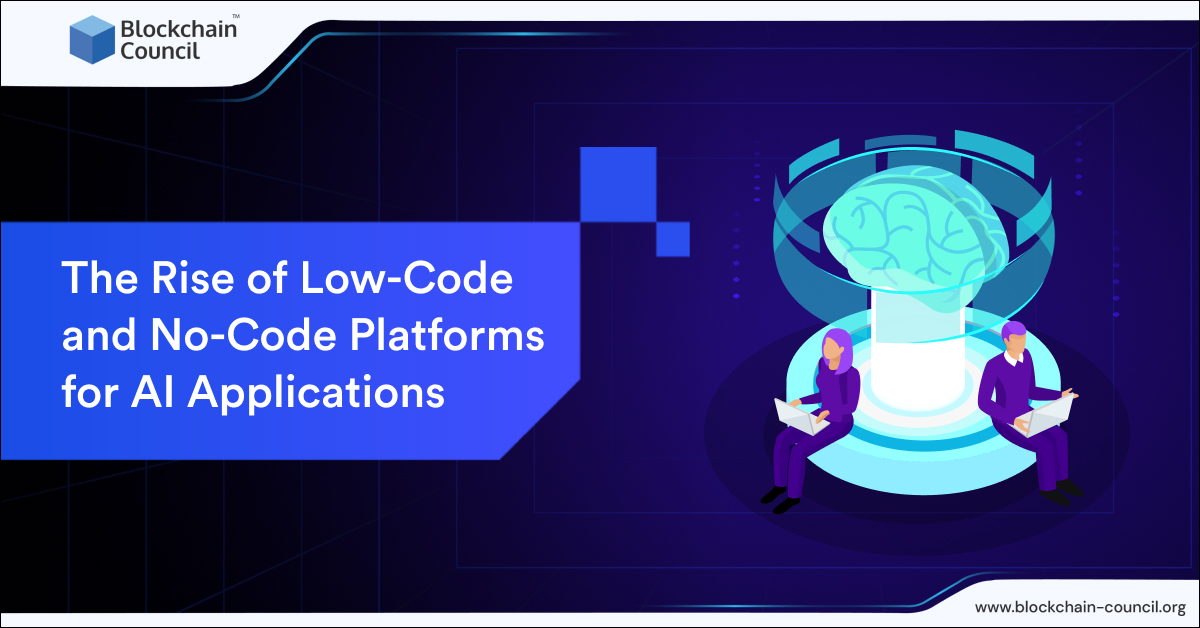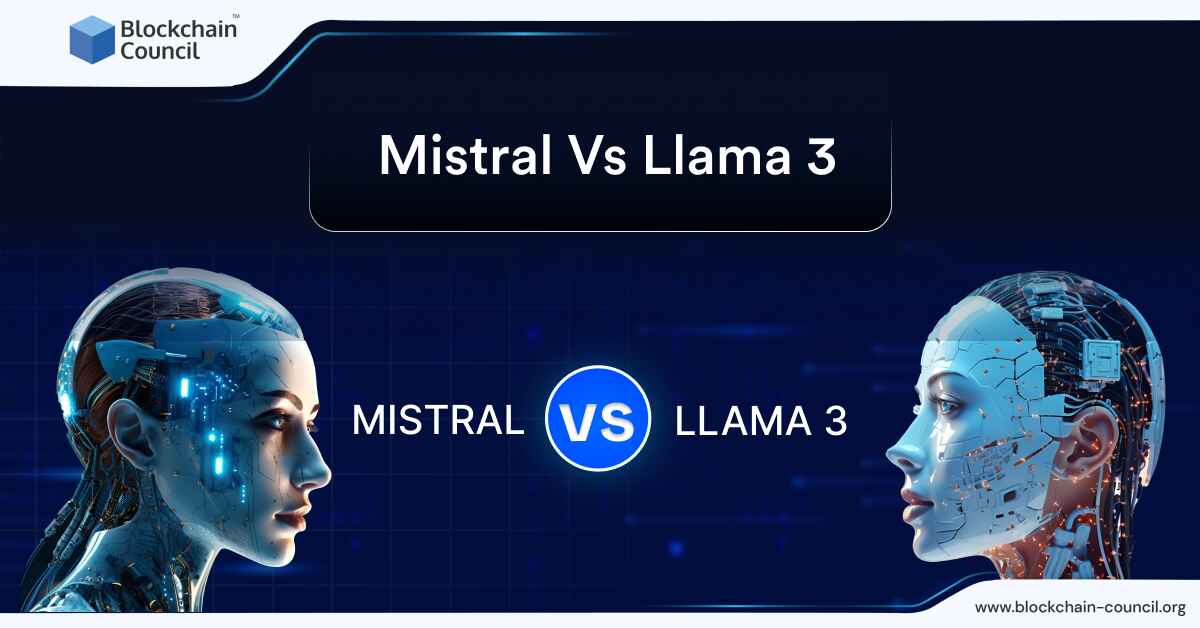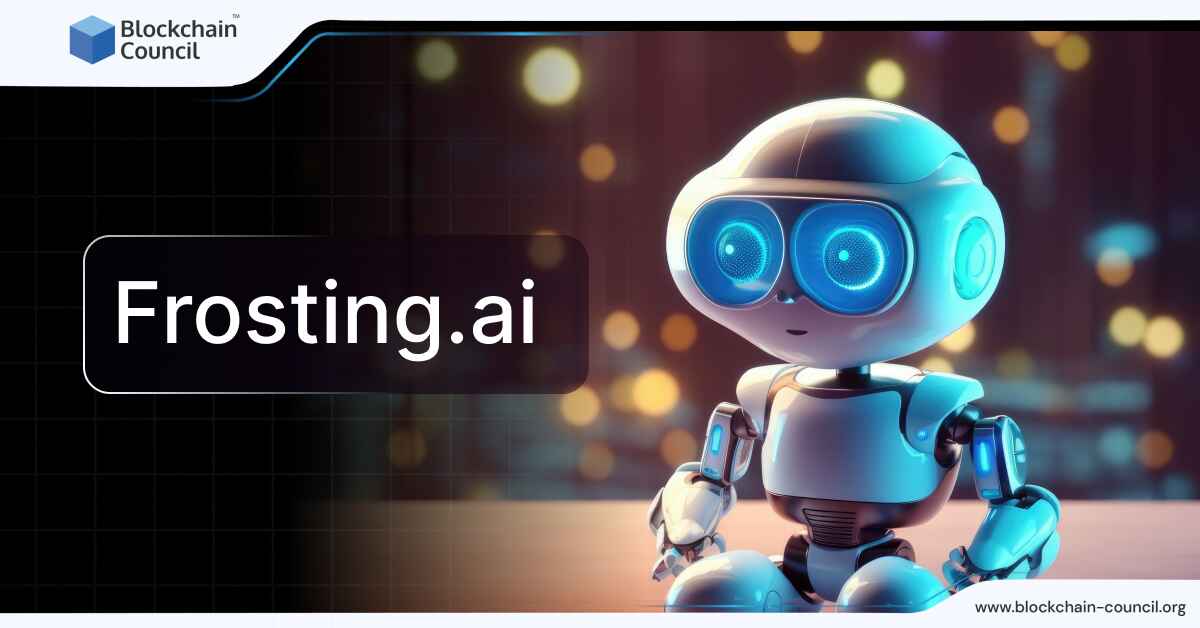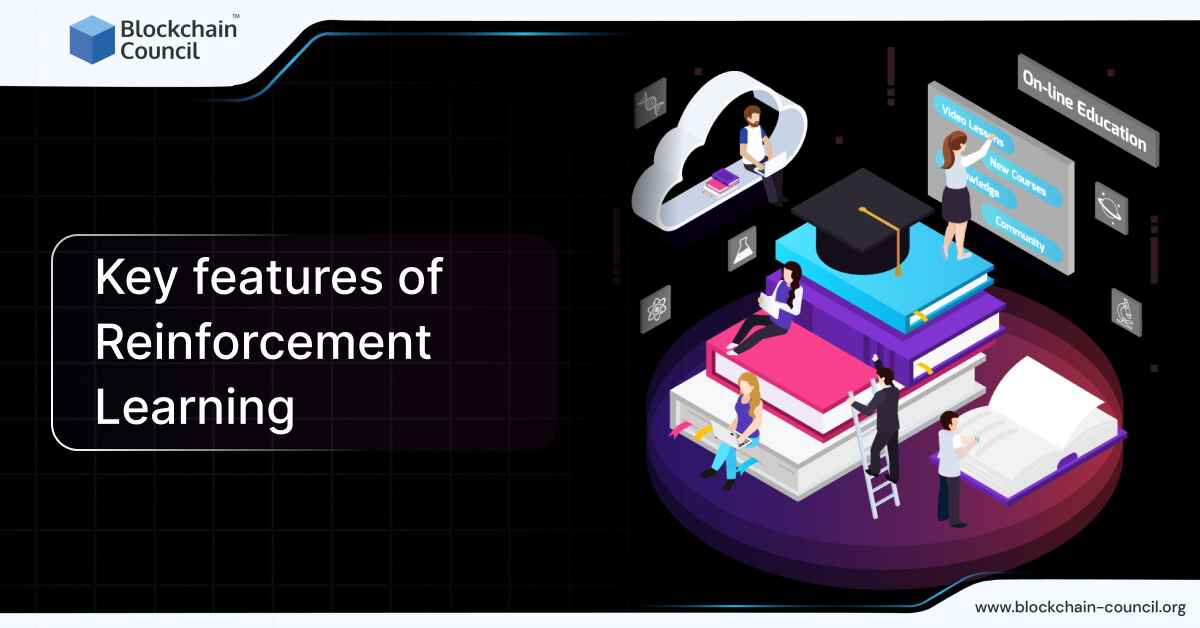
- Blockchain Council
- June 09, 2023
Summary:
- Low-code and no-code platforms are revolutionizing AI development, enabling organizations of all sizes to harness the power of AI without extensive coding knowledge.
- The global low-code market is projected to reach $257.9 billion by 2026, and the no-code market is expected to reach $11.2 billion by 2025.
- Low-code development emphasizes visual modeling and abstraction, allowing users to create applications with minimal hand-coding. Users can integrate AI algorithms, machine learning models, and data analysis tools through a drag-and-drop interface.
- No-code development eliminates the need for programming or coding knowledge altogether. Users can build applications using pre-built blocks, widgets, and logic elements, often with integrations with AI-as-a-Service providers.
- Low-code platforms require basic technical knowledge and offer more flexibility and customization options through the ability to write custom code. No-code platforms prioritize simplicity and ease of use, making AI development accessible to a broader audience.
- Benefits of low-code and no-code AI development include accelerated application development, democratization of AI, and enhanced collaboration between technical and non-technical teams.
- Low-code and no-code platforms offer features such as visual interface design, pre-built AI components and models, integration with external data sources and APIs, and automated model training and deployment.
- Top low-code platforms for AI development include Amazon SageMaker, Microsoft Lobe, Apple CreateML, IBM Watson Studio, and Appian.
- Top no-code platforms for AI development include Google AutoML, Teachable Machine, MonkeyLearn, MakeML, and RunwayML.
- Challenges and limitations of low-code and no-code AI development include the complexity of advanced AI algorithms, potential limitations in customization and fine-grained control, and the need for careful consideration of data privacy and security.
The landscape of AI development is undergoing a profound transformation with the rise of low-code and no-code platforms. These innovative tools are revolutionizing the way businesses create AI applications, making it possible for organizations of all sizes to harness the power of artificial intelligence without extensive coding knowledge.
According to Gartner, the global low-code market is projected to reach $257.9 billion by 2026, while the no-code market is expected to reach $11.2 billion by 2025. This exponential growth showcases the increasing demand for AI-powered applications and highlights the immense impact of low-code and no-code platforms in enabling AI development for all. Let’s explore how these platforms are shaping the future of AI.
Understanding Low-Code and No-Code AI Development
Low-Code Development
Low-code development refers to a software development approach that emphasizes visual modeling and abstraction, enabling users to create applications with minimal hand-coding. These platforms provide a graphical interface where users can assemble pre-built components and logic, reducing the need for traditional coding practices.
With low code, even individuals with limited programming expertise can leverage AI capabilities. Through a drag-and-drop interface, users can integrate AI algorithms, machine learning models, and data analysis tools into their applications. This empowers them to harness the power of AI for tasks such as image recognition, natural language processing, and predictive analytics.
Low-code platforms offer a wide range of features, including ready-to-use AI components, automated code generation, and seamless integration with external APIs and services. These platforms allow users to prototype and deploy AI-powered applications quickly, reducing time-to-market and enabling rapid iteration based on user feedback.
No-Code Development
No-code development takes the concept of low-code a step further by eliminating the need for any programming or coding knowledge altogether. No-code platforms provide an intuitive visual interface, empowering users to build applications using a collection of pre-built blocks, widgets, and logic elements.
With no-code AI development, individuals without technical backgrounds can harness the power of AI algorithms without writing a single line of code. These platforms offer a library of AI-enabled modules and connectors that allow users to incorporate AI functionalities seamlessly.
No-code platforms often provide AI capabilities through integrations with AI-as-a-Service providers, allowing users to leverage pre-trained models and sophisticated algorithms. This enables them to implement AI-driven features such as sentiment analysis, chatbots, recommendation systems, and more into their applications without the need for complex coding.
Similarities and Differences between Low-Code and No-Code
While both low-code and no-code development aim to simplify application development, they differ in the level of technical expertise required and the flexibility they offer.
- Technical Expertise: Low-code platforms assume a basic level of technical knowledge, as users are still required to understand programming concepts and logic. No-code platforms, on the other hand, remove this barrier by providing a highly intuitive interface that allows anyone, regardless of technical expertise, to build AI-powered applications.
- Flexibility: Low-code platforms offer more flexibility and customization options, as they allow users to write custom code in addition to visual modeling. This makes them suitable for professionals who require fine-grained control over their applications. No-code platforms prioritize simplicity and ease of use, sacrificing some flexibility in favor of accessibility.
Despite these differences, both low-code and no-code development democratize AI by making it accessible to a broader audience. They enable individuals with varying technical backgrounds to leverage AI technologies and drive innovation without the need for extensive coding knowledge.
Benefits of Low-Code and No-Code AI Development
Accelerated Application Development
Low-code and no-code AI development offers a fast track to creating powerful applications with minimal manual coding. These platforms provide an intuitive visual interface coupled with pre-built AI components, enabling developers to rapidly design, develop, and deploy applications. Let’s delve into the key benefits:
- Rapid Prototyping: Low-code and no-code AI development empower developers to quickly prototype and iterate ideas, significantly reducing the time and effort required for initial application development. The visual drag-and-drop interface allows for the swift creation of user interfaces, data integration, and logic implementation.
- Streamlined Development Process: By abstracting complex coding tasks, low-code, and no-code platforms enable developers to focus on the application’s core functionality. With reusable templates and pre-configured AI models, developers can seamlessly integrate AI capabilities into their applications, enhancing efficiency and reducing development cycles.
- Agile Iterations: These platforms facilitate agile development methodologies by empowering developers to adapt and iterate on applications based on user feedback and evolving requirements. By leveraging low-code and no-code AI development, organizations can quickly respond to market demands and stay ahead of the competition.
Democratization of AI
- Inclusive Innovation: Low-code and no-code AI development break down barriers, allowing a broader audience to participate in AI-driven innovation. Business professionals, domain experts, and citizen developers can now actively contribute to the creation of AI-powered solutions, unlocking new possibilities and perspectives.
- Skills Amplification: These platforms provide an opportunity for individuals to upskill and amplify their existing expertise. With visual interfaces and guided workflows, even those with limited coding knowledge can harness the power of AI, accelerating their learning curve and expanding their professional capabilities.
- Rapid Deployment: The democratization of AI through low-code and no-code platforms expedites the deployment of intelligent applications. With reduced reliance on specialized development resources, organizations can scale their AI initiatives faster, leading to quicker time-to-market and increased competitive advantage.
Enhanced Collaboration Between Technical and Non-Technical Teams
Low-code and no-code AI development bridge the gap between technical and non-technical teams, fostering collaboration and facilitating the exchange of ideas. Let’s delve into the advantages of this enhanced collaboration:
1. Clear Communication: The visual nature of low-code and no-code platforms allows technical and non-technical stakeholders to communicate and collaborate effectively. Concepts, requirements, and workflows can be easily shared and understood, minimizing miscommunication and enhancing project outcomes.
2. Alignment of Business Goals: Low-code and no-code AI development facilitates a closer alignment between business goals and technical implementation. Non-technical teams can actively contribute to the development process, ensuring that AI applications address specific business needs and deliver tangible value.
3. Iterative Feedback Loops: The collaborative environment fostered by low-code and no-code platforms enables continuous feedback loops between technical and non-technical teams. This iterative process allows for the refinement and enhancement of AI models, ensuring that the final application meets the desired objectives.
Become a Certified Artificial Intelligence Expert™ Today
Key Features and Capabilities of Low-Code and No-Code Platforms
Visual Interface for Designing AI Applications
One of the most exciting capabilities of low-code and no-code platforms is their ability to enable the creation of AI applications through a user-friendly visual interface. Gone are the days when coding expertise was a prerequisite for leveraging the potential of artificial intelligence. With these platforms, users can drag and drop pre-built AI components, such as image recognition, natural language processing, and predictive analytics, onto a canvas, allowing for seamless integration of AI into their applications.
The visual interface provides an intuitive way to design, train, and fine-tune machine learning models. Users can visually define input data, configure model parameters, and monitor model performance in real time. This empowers both beginners and professionals to harness the power of AI, opening up a world of possibilities for automation, data analysis, and enhanced decision-making.
Pre-built AI Components and Models
Low-code and no-code platforms come equipped with an extensive library of pre-built AI components and models. These components encapsulate complex algorithms and functionalities, enabling users to leverage the power of cutting-edge technologies without the need for specialized knowledge. From sentiment analysis to object detection, these ready-to-use components accelerate the development process and eliminate the need to start from scratch.
Moreover, these platforms often support integration with popular AI frameworks, allowing users to import custom models and incorporate them seamlessly into their applications. This flexibility enables professionals to leverage their existing expertise and build upon pre-existing AI models, further expanding the capabilities of their applications.
Integration with External Data Sources and APIs
To build robust and data-driven applications, low-code and no-code platforms offer seamless integration with external data sources and APIs. This capability allows users to connect their applications to a wide range of data repositories, such as databases, cloud storage, or web services, unlocking a wealth of information for analysis and decision-making.
Through simple configurations and intuitive interfaces, users can establish data connections, retrieve real-time data, and incorporate it into their applications. This empowers businesses to create dynamic and responsive solutions, harnessing the power of real-time information for improved customer experiences, data-driven insights, and process automation.
Automated Model Training and Deployment
Traditionally, training and deploying machine learning models required a significant investment of time, resources, and technical expertise. However, low-code and no-code platforms streamline this process through automated model training and deployment capabilities. These platforms provide an end-to-end workflow, allowing users to upload training data, define the target variables, and automatically generate models.
Furthermore, these platforms often offer built-in mechanisms for model deployment, making it easy to push the trained models into production environments. This seamless transition from development to deployment ensures that applications can quickly leverage the predictive power of machine learning models, enabling businesses to make data-driven decisions in real time.
Top Low-Code Platforms for AI Development
Amazon SageMaker
Amazon SageMaker is a fully managed machine learning platform that helps developers and data scientists build, train, and deploy machine learning models quickly and easily. SageMaker provides a wide range of features, including:
A visual drag-and-drop interface for building machine learning models
Pre-built algorithms and models
A built-in machine-learning engine
Connectors to a wide range of third-party services
SageMaker is a powerful platform that can be used to build a wide range of AI-powered applications, including:
Customer churn prediction
Fraud detection
Product recommendations
Image classification
Natural language processing
Microsoft Lobe
Microsoft Lobe is a low-code AI development platform that helps users build and deploy machine learning models without writing any code. Lobe provides a wide range of features, including:
A visual drag-and-drop interface for building machine learning models
Pre-built algorithms and models
A built-in machine-learning engine
Connectors to a wide range of third-party services
Lobe is a great platform for users who want to get started with AI development without having to learn how to code. It is also a good choice for users who want to build simple AI-powered applications quickly and easily.
Apple CreateML
Apple CreateML is a machine learning framework that helps developers build machine learning models on Apple devices. CreateML provides a wide range of features, including:
A visual drag-and-drop interface for building machine learning models
Pre-built algorithms and models
A built-in machine-learning engine
CreateML is a great platform for developers who want to build machine-learning models for Apple devices. It is also a good choice for developers who want to learn about machine learning without having to learn how to code.
IBM Watson Studio
IBM Watson Studio is a cloud-based platform that helps developers build, train, and deploy machine learning models. Watson Studio provides a wide range of features, including:
A visual drag-and-drop interface for building machine learning models
Pre-built algorithms and models
A built-in machine-learning engine
Connectors to a wide range of third-party services
Watson Studio is a powerful platform that can be used to build a wide range of AI-powered applications, including:
Customer churn prediction
Fraud detection
Product recommendations
Image classification
Natural language processing
Watson Studio is a good choice for users who want to build complex AI-powered applications. It is also a good choice for users who want to collaborate with other developers on AI projects.
Appian
Appian is a low-code platform that specializes in business process automation. Appian offers a wide range of features for AI development, including:
A visual drag-and-drop interface
Pre-built components
Connectors to a wide range of third-party services
A built-in machine-learning engine
Appian is a powerful platform that can be used to build complex business process automation applications quickly and easily. It is also a flexible platform that can be used for a wide range of use cases. Appian can be used for a wide range of use cases, including:
Business process automation
Data analysis
Machine learning
Customer service
Order processing
Inventory management
Top No-Code Platforms for AI Development
Google AutoML
Google AutoML is a suite of machine learning tools that helps developers build machine learning models without having to write any code. AutoML provides a wide range of features, including:
A visual drag-and-drop interface for building machine learning models
Pre-built algorithms and models
A built-in machine-learning engine
Connectors to a wide range of third-party services
AutoML is a great platform for users who want to get started with AI development without having to learn how to code. It is also a good choice for users who want to build simple AI-powered applications quickly and easily.
Teachable Machine
Teachable Machine is a free, web-based platform that allows you to create machine-learning models without any coding experience. It provides a drag-and-drop interface that makes it easy to label data, train models, and test results.
Teachable Machine can be used for a variety of tasks, including:
Creating image classifiers
Developing speech recognition models
Building natural language processing applications
Teachable Machine is a great option for beginners who want to learn about machine learning and AI. It is also a good choice for businesses that want to experiment with AI without investing in expensive software or hiring a data scientist.
MonkeyLearn
MonkeyLearn is a platform that allows you to build and deploy machine learning models for natural language processing tasks. It provides a variety of pre-trained models that you can use to solve different problems, as well as tools that allow you to train your own models.
MonkeyLearn can be used for a variety of tasks, including:Sentiment analysis
Topic modeling
Named entity recognition
MonkeyLearn is a powerful tool that can be used to build complex natural language processing models. It is also easy to use, making it a good option for businesses and individuals with limited technical experience.
MakeML
MakeML is a platform that allows you to build and deploy machine learning models for computer vision tasks. It provides a variety of pre-trained models that you can use to solve different problems, as well as tools that allow you to train your own models.
MakeML can be used for a variety of tasks, including:
Object detection
Image classification
Face recognition
MakeML is a powerful tool that can be used to build complex computer vision models. It is also easy to use, making it a good option for businesses and individuals with limited technical experience.
RunwayML
RunwayML is a platform that allows you to build and deploy machine learning models for a variety of tasks. It provides a variety of pre-trained models that you can use to solve different problems, as well as tools that allow you to train your own models.
RunwayML can be used for a variety of tasks, including:
Image classification
Natural language processing
Speech recognition
RunwayML is a powerful tool that can be used to build complex machine-learning models. It is also easy to use, making it a good option for businesses and individuals with limited technical experience.
Challenges and Limitations of Low-Code and No-Code AI Development
The Complexity of Advanced AI Algorithms
While low-code and no-code platforms have simplified the development process, they can still fall short when it comes to dealing with advanced AI algorithms. These algorithms often require intricate mathematical models and extensive computational resources. Therefore, users may face limitations when attempting to implement complex AI functionalities that go beyond the capabilities of the platform.
To tackle this challenge, it is essential for developers to have a solid understanding of the underlying AI concepts and algorithms. This knowledge allows them to make informed decisions when selecting low-code or no-code platforms, ensuring compatibility with their desired AI capabilities. Additionally, collaborating with data scientists and AI experts can bridge the gap between the simplicity of low-code and no-code platforms and the complexity of advanced AI algorithms.
Customization and Scalability Constraints
Low-code and no-code platforms are designed to provide pre-built components and modules that can be easily assembled to create applications. However, this convenience can come at the cost of limited customization and scalability. Users may find themselves restricted by the platform’s predefined functionalities, which may not align perfectly with their unique requirements.
To overcome these constraints, it is crucial to carefully evaluate the customization options offered by different low-code and no-code platforms. Choosing platforms that allow for flexible customization through plugins, extensions, or integrations with other AI frameworks can provide users with the freedom to tailor their applications to specific needs. Furthermore, considering scalability requirements from the outset and selecting platforms that support easy scaling can ensure that the developed AI solutions can grow and adapt to changing demands.
Potential Impact on Job Roles and Skills
The rise of low-code and no-code AI development has sparked discussions about its potential impact on job roles and skills. As these platforms enable individuals with minimal coding experience to create AI applications, concerns have been raised regarding the future role of professional developers and data scientists.
While it is true that low-code and no-code platforms reduce the entry barrier for AI development, they do not replace the need for domain expertise and a deep understanding of AI principles. These platforms serve as tools to democratize AI development, allowing individuals to prototype and build solutions quickly. However, for complex and mission-critical applications, the involvement of skilled developers and data scientists remains indispensable. They possess the knowledge and expertise required to optimize AI algorithms, handle data intricacies, and ensure robust performance and security.
Future Trends and Innovations in Low-Code and No-Code AI Development
Advancements in Natural Language Processing Capabilities:
Natural language processing (NLP) is undergoing rapid advancements, enabling low-code and no-code AI development to leverage the power of language understanding. NLP algorithms can analyze, interpret, and respond to human language, opening doors to more intuitive user experiences and improved automation capabilities.
NLP breakthroughs, such as transformer models like GPT-4, have revolutionized the field by generating human-like text and providing valuable insights. Low-code and no-code platforms are integrating these NLP capabilities, allowing developers to create intelligent chatbots, language-based recommendation systems, and voice-controlled applications with ease.
These advancements in NLP not only streamline the development process but also enhance user engagement and satisfaction. By leveraging the natural language processing capabilities of low-code and no-code platforms, developers can create applications that understand and respond to users’ queries and commands effectively.
Integration of AI with Internet of Things (IoT) devices:
The Internet of Things (IoT) has witnessed exponential growth, connecting numerous devices and generating vast amounts of data. The integration of AI with IoT devices unlocks unprecedented opportunities for automation, predictive analytics, and smart decision-making.
Low-code and no-code platforms are now enabling developers to build AI-powered IoT applications without the need for extensive coding expertise. By leveraging pre-built AI models and visual development interfaces, developers can connect and control IoT devices seamlessly.
With the convergence of AI and IoT, low-code and no-code platforms offer users the ability to develop intelligent systems capable of real-time data analysis, remote monitoring, and predictive maintenance. This integration paves the way for applications such as smart homes, industrial automation, and efficient supply chain management.
The Role of Augmented Analytics in Low-Code and No-Code Platforms:
Augmented analytics is an emerging trend that empowers developers with advanced data analytics capabilities, making complex insights more accessible to users without specialized data science skills.
Low-code and no-code platforms are incorporating augmented analytics tools, allowing developers to extract meaningful information from vast datasets effortlessly. By leveraging AI algorithms, these platforms provide automated data preparation, exploratory data analysis, and predictive modeling.
This integration of augmented analytics with low-code and no-code platforms democratizes data science, enabling users to uncover hidden patterns, perform sentiment analysis, and make data-driven decisions. From business intelligence dashboards to personalized recommendations, augmented analytics empowers developers to create sophisticated applications that deliver valuable insights to end-users.
Learn Low-Code and No-Code AI Development with the Blockchain Council Certifications
The following AI certifications by the Blockchain Council are important for low-code and no-code AI development:
Certified Artificial Intelligence (AI) Expert™
This certification is designed to help you learn the basics of AI, including machine learning, deep learning, and natural language processing. It is a good starting point for anyone who wants to learn about AI and how to use it in low code and no code development.
Certified ChatGPT Expert
This certification is designed to help you learn how to use ChatGPT, a powerful AI language model. ChatGPT can be used to create chatbots, generate text, and answer questions. This certification will give you the skills you need to use ChatGPT in your low-code and no-code development projects.
Certified Chatbot Expert™
This certification is designed to help you learn how to create chatbots. Chatbots are software programs that can simulate conversations with humans. They can be used for a variety of purposes, such as customer service, marketing, and education. This certification will give you the skills you need to create AI chatbots that can help you automate tasks and improve customer experience.
These certifications can help you gain the skills you need to develop low-code and no-code AI applications. As the demand for AI-powered applications continues to grow, these certifications can help you make yourself more marketable to potential employers.
In addition to the technical skills that these certifications will teach you, they will also help you develop your problem-solving skills and your ability to think critically. These are important skills for any developer, but they are especially important for AI developers. AI is a complex field, and there are often no easy answers to the problems that you will face. The ability to think critically and to come up with creative solutions will be essential for your success as an AI developer.
Become a Certified Artificial Intelligence Expert™ Today
Conclusion
The advent of low-code and no-code platforms has marked a significant turning point in the landscape of AI application development. By eliminating the barrier of technical coding skills, these platforms have opened the doors to a broader range of individuals and organizations, enabling them to harness the power of artificial intelligence.
Real-world applications of low-code and no-code AI platforms are already making waves across various sectors. Businesses can automate tasks, enhance customer service, and make data-driven decisions with ease. Individuals, on the other hand, can create personalized learning experiences, manage finances, and stay informed using AI-driven applications.
As low-code and no-code AI platforms continue to evolve, we can anticipate a surge in innovative and creative applications. This is an exciting era for artificial intelligence, brimming with limitless possibilities. The accessibility and usability of these platforms empower users to explore AI in way previously unimaginable.
Frequently Asked Questions
- Low-code development is a software development approach that emphasizes visual modeling and abstraction.
- It allows users to create applications with minimal coding.
- No-code development eliminates the need for coding or programming knowledge altogether.
- It provides an intuitive visual interface for building applications using pre-built blocks and logic elements.
- Low-code platforms require some level of programming knowledge and offer more flexibility and customization options.
- No-code platforms eliminate the need for coding knowledge and prioritize simplicity and ease of use.
- Accelerated application development through rapid prototyping and streamlined development processes.
- Democratization of AI, allowing individuals with varying technical backgrounds to participate in AI-driven innovation.
- Enhanced collaboration between technical and non-technical teams, fostering clear communication and alignment of business goals.
- Visual interface for designing AI applications.
- Pre-built AI components and models for easy integration.
- Integration with external data sources and APIs for data-driven applications.
- Automated model training and deployment for efficient development processes.
- Low-code platforms: Amazon SageMaker, Microsoft Lobe, Apple CreateML, IBM Watson Studio, Appian.
- No-code platforms: Google AutoML, Teachable Machine, MonkeyLearn, MakeML, RunwayML.





































































 Guides
Guides News
News Blockchain
Blockchain Cryptocurrency
& Digital Assets
Cryptocurrency
& Digital Assets Web3
Web3 Metaverse & NFTs
Metaverse & NFTs
